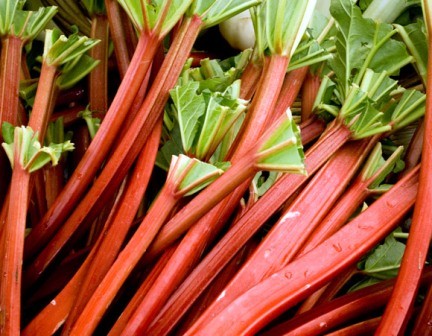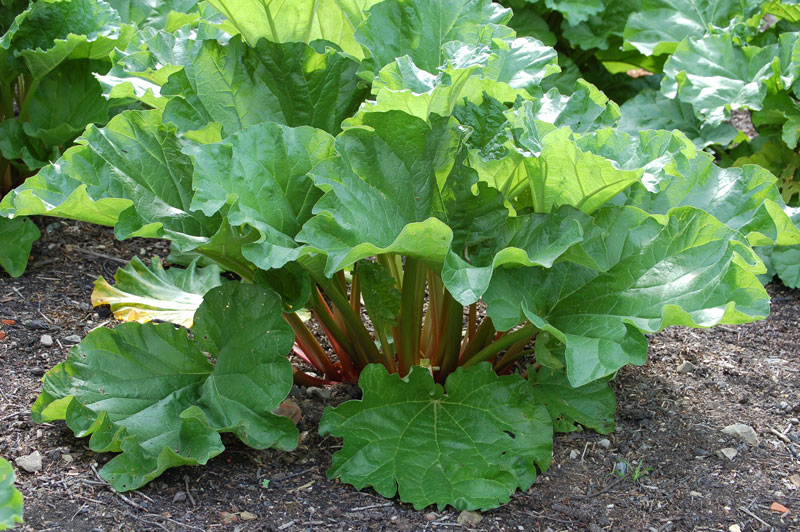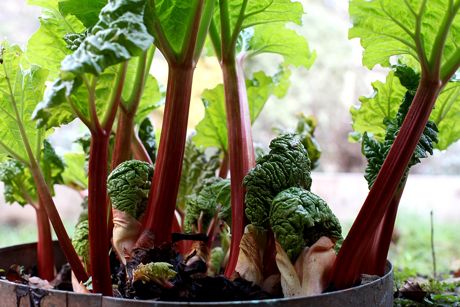As with Nadia’s amazing rhubarb recipes, when it comes to growing rhubarb there’s enough to talk about that we’re going to break this baby into two parts. First up: the basics. What does rhubarb actually look like before it’s all cut up in a pie? And the big question: “Are you serious? You want me to grow rhubarb on my balcony?” Yes. I’m serious. (After I’ve talked you into it, I’ll be back with Part Two: The Nitty Gritty Planting Instructions).
The first thing you need to know is that rhubarb gets BIG. If you were the Queen of the Nile and you got tired of your servants fanning you with palm fronds, you could sub in rhubarb leaves and the swish of air would be bigger and better. If you were lost in the woods and needed to make a rain shelter, two, maybe three rhubarb leaves and you’d be good for the night. If you were being cast out of the Garden of Eden and wanted attire more modest than a fig leaf, you could wrap yourself in a couple of rhubarb leaves and get all the way to PG.
To reiterate, rhubarb leaves: they’re big. And rhubarb plants produce lots of leaves. But as Nadia pointed out, the leaves aren’t the part you eat. In fact, they’re crazy poisonous. Rhubarb stalks are the yummy part, and they’re big too, up to two feet long. Pretty much, compared to the rest of the vegetables in your garden, rhubarb plants are like an Escalade in a parking lot full of Minis.
A gargantuan plant is no problem if you live in the burbs. But if you have a container garden in the city, rhubarb’s size means its a non-starter, right? Wrong! (You knew I was going to say that). You CAN grow rhubarb in a container. It just has to be a big container. Just how big is this big container? The plants spread about three to four feet, so you want a container that’s at least three feet across. When you go to the garden center, head straight for the containers that look like they could hold small trees. Those are the ones for you.
The next thing you need to know is that rhubarb is a perennial. That means it comes back year after year. No seeds to plant every spring. No expense to incur every year. Plant rhubarb now, and you can be eating rhubarb pies from the same plant five years from now.
The plant dies back in the fall, after the first frost, and come spring, new leaves and stalks emerge again from the soil. Like so:
Right around June, the stalks are ready for harvest. Keep the plant strong by cutting only a third or so of the stalks. (The stalks and leaves you leave behind will keep photosynthesizing until fall and help the plant store up nutrients for next spring).
An eternal plant you have to care for year-round may sound scary, but rhubarb is, in fact, surprisingly easy. Rhubarb doesn’t need much fertilizer at all. It isn’t prone to pests or diseases. Unlike sun guzzlers, rhubarb can even handle part shade (less than six hours of sun a day). Really, all it needs from you is a big pot, consistent watering, and for you to live in a place where temperatures in the winter drop below 40 degrees (cold kickstarts its regrowth every year).
The best part of the whole thing is how delicious rhubarb is and the direct access you have to this deliciousness if you grow it yourself. But close second, I’d say, is the show stopper factor. Huge leaves? Crimson stalks? You’re going to want to give it an ovation every time you see it.
Tags: rhubarb



HA. Loved this: you could wrap yourself in a couple of rhubarb leaves and get all the way to PG.
🙂